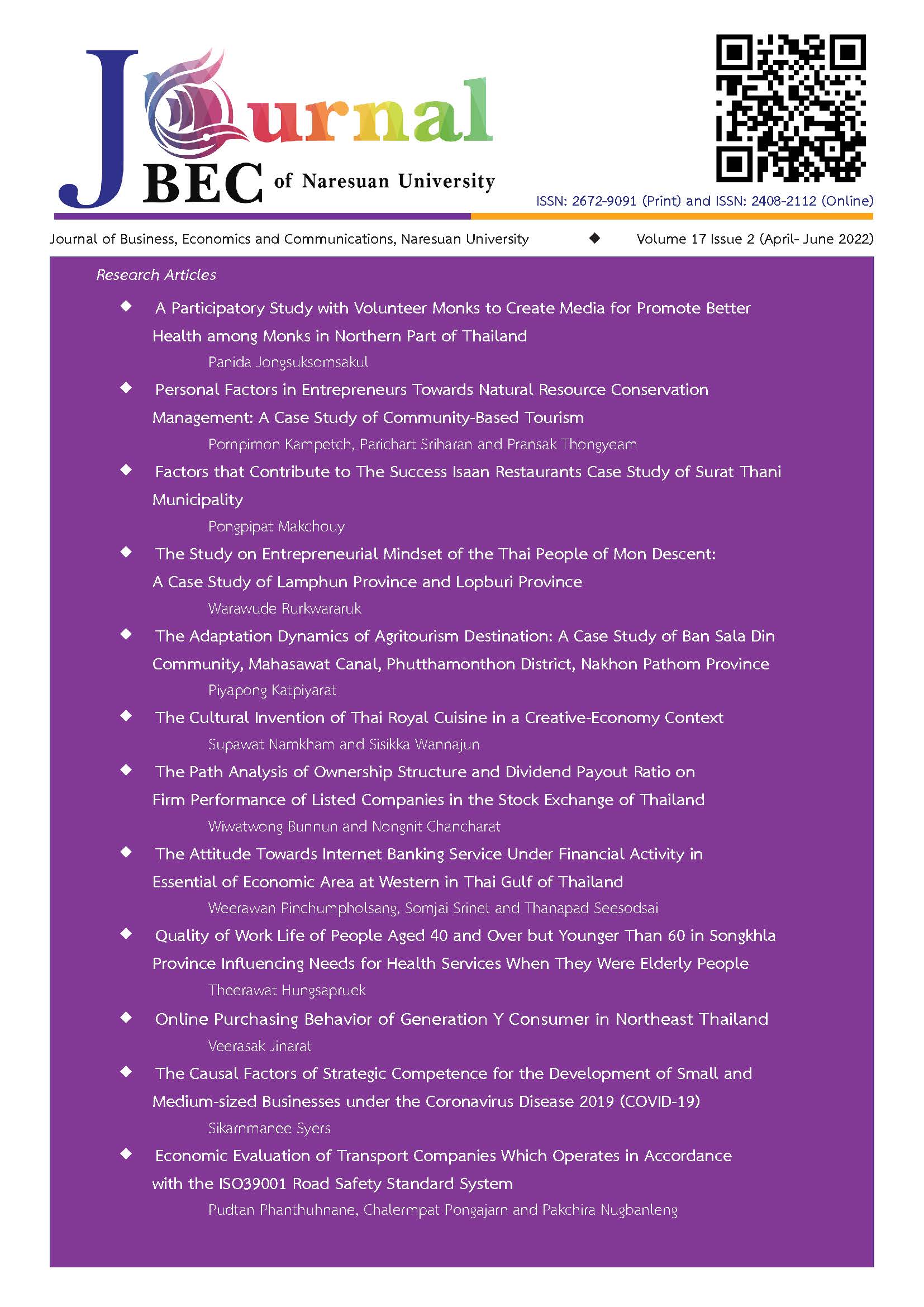The Causal Factors of Strategic Competence for the Development of Small and Medium-Sized Businesses under the Coronavirus Disease 2019 (COVID-19)
Main Article Content
Abstract
This research on the causal factors of strategic competence for the development of small and medium-sized businesses under the coronavirus disease 2019 (COVID-19) used questionnaires to gather data from 400 SME businesses registered with the Department of Business Development (DBD). The study found that strategic advantage (SA) received positive influences directly and indirectly from dynamic managerial capabilities (DMC) and organization capabilities (OC). Upon evaluating each factor, it was found that dynamic managerial capabilities (DMC) directly influenced strategic advantage (SA) at the level of 0.30 with indirect influence at the level of 0.11. Organization Capabilities (OC) were a mediator variable. Additionally, upon consideration of the direct influences with causal correlations with the variable of organization capabilities (OC), direct influences were received from dynamic managerial capabilities (DMC) at a level of 0.23, which supports the research hypotheses.
Article Details

This work is licensed under a Creative Commons Attribution-NonCommercial-NoDerivatives 4.0 International License.
References
Adam, A. M. (2020). Sample size determination in survey research. Journal of Scientific Research and Reports, 22(1). 90-97.
Ambrosini, V. and Altintas, G. (2019). Dynamic managerial capabilities. In Oxford Research Encyclopedia of Business and Management., 2019 Jun 25, 10-14.
Atsani, T. (2015). Linear analysis in social science research for non-recursive models. Journal of Education, 16(1). 10-12.
Boyatzis, R. E. (1982). The competent manager: A model for effective performance. JOHN WILEY & SONS AUSTRALIA, LTD. 144-152.
Chaturonratsami. C. (2017). Specification of the main capabilities and management capabilities for developing tourism businesses and hotel services in Phra Nakhon Si Ayutthaya. ARU Research Journal Humanities and Social Sciences, 4(2), 81-88.
Chaithiang, N. (2021). Prevention measures for the new COVID-19 outbreak. Public Health Policy and Laws Journal, 7(3), 541-554.
Department of Employment. (2021). Project to help SMEs through the Cabinet, spending 37 billion bath, subsidized wages, 3,000 per head. Retrieved December 11, 2021, from https://www.doe.go.th/prd/main/news/param/site/1/
cat/7/sub/0/pull/detail/view/detail/object_id/51682
Espedal, B. (2005). Management development: Using internal or external resources in developing core competence. Human Resource Development Review, SAGE Publicztions, 4(2), 136-158.
Fagerland, M. W. and Hosmer, D. W. (2013). A goodness‐of‐fit test for the proportional odds regression model. Statistics in medicine, John Wiley & Sons, Ltd.,32(13), 2235-2249.
Helfat, C. E. and Martin, J. A. (2015). Dynamic managerial capabilities: Review and assessment of managerial impact on strategic change. Journal of management, 41(5), 1281-1312.
Hollenbeck, G. P., & McCall, M. W. (2003). Competence, not competencies: Making global executive development work. In Advances in global leadership. Emerald Group Publishing Limited. 4(3),5-20.
Kyophilavong, P., and Souksavath, S. (2016). Laos: Economic and social development towards the ASEAN Economic Community (AEC). In Regional Community Building in East Asia, 21(2), pp. 104-122.
Krejcie, R. V. and Morgan, D. W. (1970). Determining sample size for research activities. Educational and psychological measurement, University of Minnesota, Duluth. 30(3), 607-610.
Khammadi, P., Khongklai, C. and Kittisaknawin, C. (2014). Strategic human resources work for organization innovations and knowledge management capabilities. Journal of Graduate Studies Vala Alongkorn Rajabhat University, 11(2), 216-225.
Marks, R. B., Sibley, S. D. and Arbaugh, J. B. (2005). A structural equation model of predictors for effective online learning. Journal of management education, 29(4), 531-563.
Mongkhonchai-aranya, P. (2018). Dynamic capabilities, dynamic capabilities. Journal of Liberal Arts and Management Kasetsart University, 1(1), 67-79.
Mo, P. (2017). Drafting of ministerial announcement specifying "other businesses" pursuant to Section 3 of the Small and Medium Enterprises Promotion Act, B.E. 2543 (2000). Ramkhamhaeng Law Journal, 7(2), 163-163.
Phaksuwan, S. (2020). Project promoting small and medium-sized businesses of the Federation of Thai Industries for the survival of Thai SMEs in the ASEAN Economic Community. Journal of the Association of Researchers, 25(3), 31-42.
Phonhan, W. (2016). Causal relationship model for factors affecting organization of learning status of schools under Secondary Educational Service Area Office 23. Journal of Graduate School Sakon Nakhon Rajabhat University, 13(62), 38-50.
Reillier, L. C. and Reillier, B. (2017). Platform strategy: How to unlock the power of communities and networks to grow your business. (1st ed.), In London, 112-115
Siwirot, S. and Bunthanomtirat, P. (2020). Temporary accounting relief measures during COVID-19. EAU Heritage Journal Social Science and Humanities, 10(2), 77-86.
Suwanniphon, W. (2014). Human capital potential and dynamic capabilities of entrepreneurs in the Thai software industry for enhancing competitive capabilities in the ASEAN Economic Community. Veridian E-Journal, Silpakorn University (Humanities, Social Sciences and Arts), 10(3), 1-20.
Thiphakorn, S., Chetsadalak, W. and Saensuk, C. (2015). Causal factors and outcomes of complexity management capabilities of small and medium-sized businesses (SMEs) in Thailand. Business Review Journal, 10(2), 217-234.
Thongsamsi, I. and Thongsamsi, K. (2021). Meta-analysis of research related to learning management methods in the research procedures subject and research data analysis subject. Princess Narathiwat University. Journal of Humanities and Social Sciences, 8(2), 127-146.
Thongthip. B. (2020). Coronavirus 2019 (COVID-19) and capabilities of leaders for developing organizations in the new normal. Journal of Social Science and Buddhistic Anthropology, 11(5). 2-5.
Ulrich, D., and Lake, D. G. (1990). Organizational capability: Competing from the inside out. New York: John Wiley & Sons, Inc., 98 - 110.
Wongwithit, S. (2018). Draft of ministerial regulation specifying the types of small and medium-sized businesses or small and medium enterprise and private organizations that have to report statistical data to governmental bodies, government agencies or state enterprises pursuant to Section 40. Journal of MCU Peace studies, 6(4), 1694-1707.
Zagalsky, A., Te'eni, D., Yahav, I., Schwartz, D. G., Silverman, G., Cohen, D., and Lewinsky, D. (2021). The Design of Reciprocal Learning Between Human and Artificial Intelligence. Proceedings of the ACM on Human-Computer Interaction, Volume 5, Issue CSCW2, Article No. 443, 1-36.


